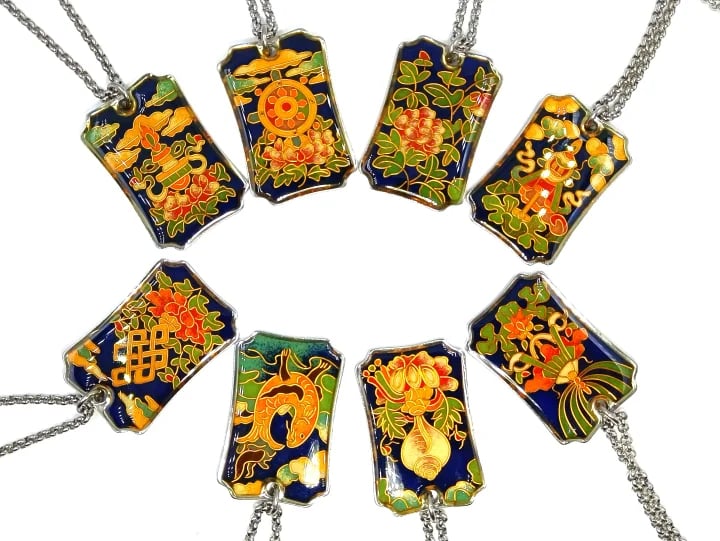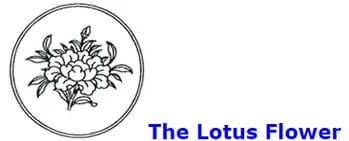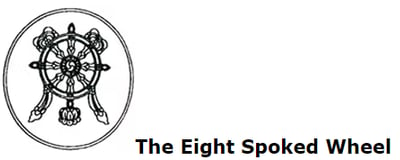The Eight Auspicious Symbols
These eight symbols appear often in Tibetan religious art. They are particularly prevalent in sand mandalas and are believed to be the symbolic representation of the transient universe.
10/22/20249 min leggere


The Eight Auspicious Symbols
The Eight Auspicious Symbols of Tibetan Buddhism
These eight symbols appear often in Tibetan religious art. They are particularly prevalent in sand mandalas and are believed to be the symbolic representation of the transient universe.
The Precious Parasol
What does the enamel gem parasol represent?
The story about the Buddha using a parasol to protect sentient beings mentioned in "Mahayana Awakening of Faith" refers to a fable in the "Infinite Life Sutra", which is called "Maha Vairocana's Enlightenment". This story is often called "Buddha's Parasol" or "Sakyamuni Buddha's Parasol".
The story tells that before the Buddha became enlightened, he encountered various difficulties and temptations during his practice. At one of these moments, while the Buddha was meditating under the Bodhi tree, the demon king Vipassi attacked the Buddha with strong winds and violent rainstorms in an attempt to disrupt his practice.
The Buddha was badly beaten by the strong wind and rain, but he sat there firmly and concentrated on his practice. At this critical moment, a goddess named Mayakra (sometimes called the Queen of the Past) appeared and transformed her body into a huge parasol, covering both the Buddha and the Bodhi trees around him. Rise up and protect them from the demon king.
The moral of this story is that Maya represents wisdom and compassion, and her actions symbolize the protection of wisdom and the protection of compassion. As her incarnation, the parasol protected the Buddha from external interference, allowing him to practice with peace of mind and ultimately achieve enlightenment.
The White Conch Shell
represents the fame of the Buddha’s teachings that spread in all directions like the sound of the conch shell.
In ancient India, conchs were valued quite. They even had differences in yin and yang, caste, and each had its own name (it is mentioned in the Hindu holy book "Bhagavad Gita". The name of the conch shell was that of the historical Indian prince Arjuna. "Tianshou"). In Buddhism, the right-handed conch is thought about the most auspicious things, representing the motion of the sun, moon and stars, the fantastic sounds of the Buddha and the Dharma. On the Buddha's body, hair and eyebrows are all right-handed. There are likewise conch and other advantageous marks on the Buddha's body.
The Two Golden Fish
symbolize being saved from the ocean of earthly life and suffering.
Discover the profound symbolism woven into our Handcrafted Buddhist Conch Pendant, meticulously crafted with intricate cloisonné enamel craftsmanship. This exquisite piece of jewelry transcends mere adornment, embodying centuries of spiritual wisdom and cultural significance.
In ancient Indian culture, conch shells were revered as symbols of purity, representing the sacred Ganges and Yamuna rivers. Moreover, they symbolize the balance of energies within the human body, aligning with the left and right meridians.
Within Buddhism, the conch symbolizes harmony, unity, and abundance, resonating closely with traditional Han views. Its representation as Pisces evokes feelings of happiness and prosperity, echoing the auspicious meanings associated with the carp in paintings - a symbol of longevity and fulfillment.
Handmade with meticulous attention to detail, each pendant is a testament to the artistry and devotion of skilled artisans. Wear this pendant as a reminder of the interconnectedness of all things, and let its symbolism guide you towards inner peace, prosperity, and fulfillment.
Elevate your spiritual journey and adorn yourself with the elegance of our Handcrafted Buddhist Conch Pendant. Experience the beauty of tradition and the power of symbolism with this cherished piece of wearable art.
The Knot of Eternity
represents the intertwining of wisdom and compassion, the perfection of knowledge.
The Vase of Great Treasures
a traditional symbol of good fortune representing the perfect nature of the dharma, longevity, and prosperity.
The Kumbha among the eight auspicious things symbolizes abundance and contentment, and is also called the Kumbha or Dharma bottle.
What is Buddhist jewelry enamel vase means:
Abundance and Satisfaction: Aquarius represents material and spiritual abundance, symbolizing wealth, happiness and satisfaction. It reminds people to cherish existing resources and the pursuit of inner contentment and peace.
Container of Dharma: In Buddhism, the vase is also regarded as a container of Dharma, containing the teachings and wisdom of the Buddha. It represents the transmission and reception of Buddhism and is a source of wisdom and enlightenment.
Blessings and Good Luck: The Aquarius is considered a symbol of blessing and good luck, bringing health, longevity and well-being. Wearing a vase or placing it in your home is considered a form of blessing and protection.
Buddhist jewelry enamel vase background story:
In the Buddhist tradition, the symbolism of the vase dates back to the time of the Buddha. According to legend, during the first dry season retreat (a three-month retreat) after the Buddha became a Buddha, he accepted an invitation from a nobleman to go to his mansion to receive alms. This nobleman's name was Sudhana. He made offerings to the Buddha and the Sangha with exquisite gold and silver vessels.
Among these offering vessels, there is a special copper vase called the vase. The Buddha accepted this offering and gave it a special symbolic meaning. He compared the vase to a container of Dharma, containing the infinite wisdom and compassion of the Dharma, as well as his wishes for human happiness and liberation.
Since then, the vase has become one of the important symbols in Buddhism, representing a container of abundance, contentment, and dharma. People use aquariums as objects of blessing and protection, as well as decorations and gifts to express their blessings and wishes to others.
The Victory Banner
The victory flag signifies the doctrine of enlightenment, knowledge over ignorance, overcoming all difficulties and victory.
Buddhist Necklace Enamel Victory Banner
Background Story of the Victory Banner
In Buddhist tradition, the victory banner originated from the story of Gautama Buddha's enlightenment. Legend has it that when the Buddha attained enlightenment under the Bodhi tree, he realized that the wisdom he had gained transcended verbal expression, labeling it as the "Inexpressible Law." Throughout his teachings, the Buddha utilized gestures and symbols to convey these ineffable truths, and the Victory Banner emerged as one of them
According to the legend, Buddha engaged in a profound internal battle with the demon king Mara. Before attaining enlightenment, Buddha faced numerous temptations and distractions orchestrated by Mara. However, he ultimately triumphed over these obstacles, achieving inner victory. Upon attaining enlightenment beneath the bodhi tree, Buddha waved the victory banner, symbolizing his conquest over defilements and attainment of spiritual liberation
Symbolic Meaning
Overcoming Adversities and Obstacles: The Victory Banner embodies the capacity to overcome inner struggles and external hindrances. It serves as a reminder that despite life's challenges, one can surmount obstacles and attain inner triumph
Spiritual Evolution and Awakening: Representing the journey of spiritual growth and awakening, the Victory Banner signifies transcendence from mundane limitations through practice and insight, leading to inner freedom and enlightenment.
Refuge and Protection: The Victory Banner is regarded as a symbol of refuge and protection. It imparts believers with resilience and fortitude, shielding them from malevolent forces and guiding them towards peace and contentment.
Triumph and Prosperity: Serving as an emblem of victory and prosperity, the Victory Banner encourages individuals to confront life's trials with courage and determination, fostering personal achievement and fulfillment.
By transforming the concept of the Victory banner into a banner, it continues to carry its profound symbolic significance, inspiring individuals to persevere through life's challenges and emerge victorious in their spiritual and personal endeavors.
The Lotus Flower
The lotus flower is one of the most important symbols of Buddhism.
It is the lotus of enlightenment and soul that, although rooted in the foundation, can bloom into beautiful roses. Likewise, although a person may not be a lotus person, it is still possible for him to achieve enlightenment and perfection.
Discover the Significance of Eight Auspicious Enamel Lotus Necklaces
The eight auspicious lotus is one of the important symbols in Tibetan Buddhism, which represents auspiciousness and blessings. Although there is no specific story directly related to the eight auspicious lotuses, the lotus has profound symbolic meaning in Buddhist culture.
In the Buddhist tradition, the lotus is a particularly important symbol, often associated with the Buddha and his teachings. The lotus grows in muddy water, but it can bloom into pure and beautiful flowers in a filthy environment, symbolizing that the Bodhisattva can maintain inner purity and purity during his worldly practice, and is not polluted by the external environment.
Eight Auspicious Enamel Lotus Necklaces Backstory
In a small Tibetan village, there is a young woman named Gemma. She lives in a poor family, but she has a kind and pious heart. Gemma goes to the temple outside the village every day to practice. She chants sutras silently, meditates, and tries her best to help people in the village with her good deeds.
One day, a monk named Norbu came to the village. He was touched by Gemma's piety and good deeds and gave her a beautiful glass lotus necklace inlaid with the eight auspicious symbols of Tibetan Buddhism.
Gemma accepted this precious gift and placed it around her neck. She firmly believed that this necklace would bring happiness and good fortune to her and her family.
As time passed, miracles began to happen around Gemma. The atmosphere in the village became warmer and the relationships between people became more harmonious. Gemma's good deeds and piety infected the people around her, making life in the village better.
Gemma has not forgotten her original intention. She continues to practice hard and spread her wisdom and compassion to more people. She helps the villagers resolve conflicts and prays for them, making the atmosphere in the village full of joy and peace.
Gemma's fame gradually spread to nearby villages and towns. People came here to seek her help and blessings. Gemma used her wisdom and compassion to help more people, benefiting them a lot, and making life in the village happier and better.
The Eight Spoked Wheel
The eight-spoke wheel, also known as the Dharma Wheel, represents the Eightfold Path of Buddhism. The wheel to perfection.
The meaning and background story behind Eight Spoked Wheel
The rotation and spread of the Dharma: The wheel of Dharma represents the continuous rotation and spread of the Dharma. Just like a wheel rolling forward, Buddhism continues to spread and spread in the world. This symbolizes the Buddha's teachings being spread far and wide to bring the light of wisdom and compassion.
Spiritual Liberation and Awakening: The Dharma Wheel also symbolizes inner liberation and awakening. The rotation of the Dharma wheel represents the practitioner's journey toward wisdom and liberation. By practicing Buddhism, people can transcend pain and suffering and achieve inner peace and liberation.
Cycle without beginning and end: The round shape of the Dharma Wheel symbolizes the cycle and reincarnation of life. It expresses the concept of reincarnation, as well as the eternity and universality of Buddhism. This reminds people that the changes in life are eternal and the Buddha's law is a universal truth that transcends time and space.
Expression of the Four Noble Truths: The eight spokes on the Dharma Wheel represent the Four Noble Truths (suffering, origin, cessation, and path), which are the core teachings of the Buddha's teachings. The truth of suffering represents the pain and suffering in life, the truth of suffering represents the cause of suffering, the truth of cessation represents the way to eliminate suffering, and the truth of path represents the right path to liberation.
In the background story, the Buddha's first experience of turning the wheel of Dharma was an important event in the history of Buddhism. At the Deer Park Monastery in Sarnath, the Buddha imparted his first teachings on the Four Noble Truths and the Eightfold Path to five monks who had previously practiced with him. This turning of the wheel of Dharma marked the official spread of Buddhism and provided spiritual guidance and liberation for subsequent monks and believers.
















